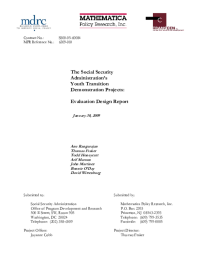Evaluation Design for the Social Security Administration’s Youth Transition Demonstration
The transition to adulthood for youth with disabilities, particularly those receiving Supplemental Security Income (SSI) or other disability program benefits, can be difficult. In addition to the host of issues facing all transition-age youth, those with disabilities face special issues related to health, social isolation, service needs, and lack of access to supports. These challenges complicate their planning for future education and work and often lead to poor educational and employment outcomes, high risk of dependency, and a lifetime of poverty.
The public cost of child dependence on SSI is quite large. In April 2005, approximately 776,000 youth 14 to 25 years old were receiving SSI benefits totaling more than $340 million each month. Many additional youth receive Childhood Disability Benefits (CDB) payments or Social Security Disability Insurance (DI) benefits. Furthermore, thousands of youth whose applications for disability benefits have been denied are at high risk of receiving benefits in the future, if they do not successfully transition to a productive adult life. This group includes youth whose disabilities are currently not severe but who have a prognosis for decreasing functioning over time, as well as youth who are ineligible due to deemed parental income but who might be eligible if they were to move out of their parents’ households after reaching age 18.
Recognizing the importance of service intervention at this critical juncture in youths’ lives, the Social Security Administration (SSA) initiated the Youth Transition Demonstration (YTD) evaluation. Focusing on youth of transition age, SSA is providing the funding to develop and rigorously evaluate promising strategies to help youth with disabilities become as economically self-sufficient as possible as they transition from school to work. Hallmark features of the YTD evaluation include (1) strong, policy-relevant demonstration projects that serve large numbers of youth with disabilities; and (2) a rigorous evaluation design based on random assignment. This report presents a detailed, comprehensive design for the YTD evaluation.






